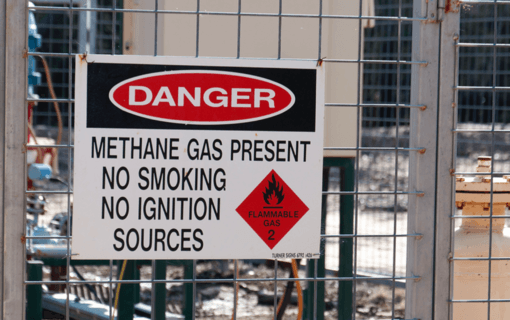
Photo by Jeremy Buckingham | CC BY 2.0
It’s January, yet methane hydrates in the Arctic are growling like an incensed monster on a scorching hot mid-summer day. But, it is January; it’s winter, not July!
On January 1st Arctic methane at 2,764 ppb spiked upwards into the atmosphere, which, according to Arctic News: “Was likely caused by methane hydrate destabilization in the sediments on the seafloor of the Arctic Ocean.” (Source: Unfolding Arctic Catastrophe, Arctic News, January 2, 2018) Once again, with emphasis, it’s January; it’s winter, and there’s little or no sunshine above the Arctic Circle. So, what gives? Why are alarming levels of methane spewing into the atmosphere in the dead of winter?
For starters, record low sea ice volume, which has been dropping like a leaden weight for years because of human-generated (anthropogenic) global warming. That’s a recipe for trouble, big time trouble as methane hydrates (lattices of ice that entrap methane molecules) get exposed to warmer water. In that regard, average sea ice volume throughout 2017 was at record lows.
Making matters worse yet, extraordinarily warm water currents flow into the Arctic from nearby ocean waters that have been absorbing 90% of global warming. Ergo, Arctic water in thin ice does not cool down without a lot of thick ice to melt the warm water currents. So, abnormally warm water remains into winter months and, in time, reaches sediments at the bottom of the ocean, disrupting methane hydrates, which have stored tonnes of methane over millennia. However, in due course, all hell breaks loose with large-scale methane eruptions, one of those “Naw, it can’t be happening” moments.
Here’s the problem: On average, sea surface temps were 23.35°F warmer during the period October 1 to December 30, 2017 compared to the 30-year average temperature. On October 25th, the sea surface was as warm as 63.5°F. For the Arctic, that’s hot, not just warmer. And, that brings forth a big-gulp question: What’s going to happen in summertime when methane hydrates are more exposed?
After all, methane (CH4) is a dominating greenhouse gas that makes carbon dioxide (CO2) look like a piker during initial years and packs the walloping risk of runaway global warming, which, in turn, threatens agricultural sources of food… not a good scenario. Imagine the chaos, considering the fact that “runaway” means totally out of control!
In all, an impending disaster seems destined to happen, but nobody knows when. It will likely occur unexpected by an ill advised, crass, blundering, philistine society blindsided by a scorched planet and extensive loss of foodstuff. Chaos spreads throughout when all of a sudden, unexpectedly, crops fail. One bad crop season follows another and another. For example, Syria, where its 2006-11 devastating drought caused 75% of Syria’s farms to fail and 85% of livestock to die. That’s a wipeout!
In the end, as crops fail, it’s too late to take remedial action beyond dealing with dystopian warring factions locked in bloodthirsty combat over morsels of foodstuff.
Not only that, one more nasty early warning sign of trouble is right around the corner: The National Snow & Ice Data Center (NSIDC) January 3rd year-end headline reads: “Baked Alaska and 2017 in Review,” stating: “… notably high temperatures prevail over most of the Arctic, especially over Central Alaska.” That’s permafrost country! That’s where tonnes and tonnes and tonnes of methane lies in-waiting to spring loose into the atmosphere. After all, global warming is the kissing cousin to methane buried in permafrost.
And, of equivalent concern on a worldwide basis: “In 2016 – now and at least for another year, the hottest year on record – global sea ice extent suffered a precipitous drop, plummeting from a fairly average 2015 value to a new record low. Now, as we wrap up 2017, data from the US National Snow and Ice Data Center (NSIDC) shows that annual average global sea ice extent has dropped again, hitting an even lower record value.” (Source: Global Sea Ice Hits New Record Low for 2nd Year Straight, The Weather Network, January 8, 2017)
Meantime, the two poles, north and south, are in the early stages of collapse. Scientists know it, and there is lots of chatter about geo-engineering and assorted methodologies to fix anthropogenic global warming before it consumes civilization in a fireball, but those proposals are in dreamland for the moment. Hopefully, one of their fixit ideas works “to scale” because the planet is likely too big for geo-engineering schemes to work without some kind of unintended consequence, which may be worse than the original fix. In fact, nobody really knows for sure what will happen when the biosphere is forced to behave according to computer-designed plans. It’s an enormous undertaking!
Therefore, it is recommended that today’s push-button, screen-watching youth learn survival skills rather than playing games for hours on end, endlessly, moronically pre-occupied with electronic fantasylands, because one day in the near future that fantasy turns to harsh reality, likely hitting hard, really hard.
After all, eco-migrants, numbering tens of thousands, are already worldwide phenomena, especially along the southern and eastern Mediterranean Sea regions, where land is turning bone dry faster than anywhere else on the planet. It’s the start of the Great Global Warming Migration scenario… but, pray tell, where to?